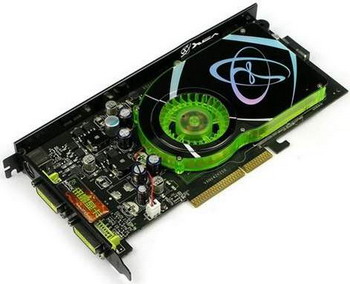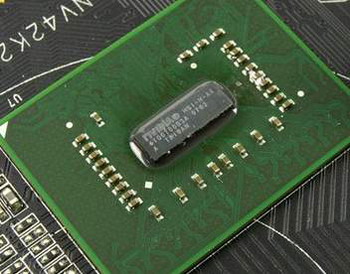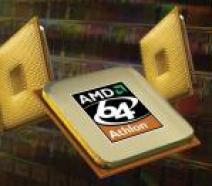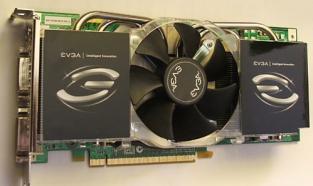OOPS! You forgot to upload swfobject.js ! You must upload this file for your form to work.
XFX 7900 GS AGP 8x preview
![]()
|
xtreview is your : Video card - cpu - memory - Hard drive - power supply unit source |
|
|||
|
|
||||
 Recommended : Free unlimited image hosting with image editor
Recommended : Free unlimited image hosting with image editor
|
POSTER: computer news || XFX 7900 GS AGP 8X PREVIEW |
DATE:2007-03-30 |
|
|
We had the capability to ascertain that XFX company not only announced the AGP- versions geForce 7900 GS and GeForce 7950 GT but also began to sell these video card. As assert video card producers , demand for graphical solutions with AGP 8x support is sufficiently high; therefore there is no need to doubt on the market success of those new card . The curiosity of overclocker was strengthened with geForce 7900 GS version ( interface PCI express x16 ) due to its famous overclocking potential. What will be the impact of transitional bridge HSI in overclock? To answer this question we used the AGP- version geForce 7900 GS from XFX.  Video card is equipped with 256 mb memory of type GDDR- 3, operating frequencies are equal to 450/320 MHz, video chip have 20 pixel shader and 5 vertex processors. This video card uses 90 nm chip g71 revision A2:  Next on the printed-circuit board it is possible to reveal the chip of transitional bridge HSI, which ensures the support of interface AGP 8x.  Video card is equipped with 1.4 ns memory from hynix production .  Concrete video card copy was overclocked from frequencies 450/1320 MHz to 550/1500 MHz. Associates subjected video card GeForce 7900 GS with interface AGP 8x to test at the default frequencies. Using motherboard asus P4c800 (Intel 875P), processor Pentium 4 3.2 GHz with 1 mb cache in the second level and 2 X 512 mb memory of type DDR400 , video card worked with drivers forceWare 93.82.  It is natural that overclock can improve those results. For example, in tests series of 3DMark increase in frequencies from 450/1320 MHz to 550/1500 MHz ensures increase in the speed by 6-13%. if we considers that existing AGP- 8x Radeon x1950 pro have poor overclocking potential , than the owners of systems with this interface type can be interested in AGP- version geForce 7900 GS. Related Products : | ||
|
|
||
|
xtreview is your : Video card - cpu - memory - Hard drive - power supply unit source |
|
|
|
|
||
|
Xtreview Support  N-Post:xxxx Xtreview Support        |
XFX 7900 GS AGP 8X PREVIEW |
| Please Feel Free to write any Comment; Thanks  |
Core i9-7900X at 5960 MHz has updated the GPUPI for CPU 1B (2017-08-08)
Core i9-7900X at a frequency of 6.0 GHz was adjacent to the overclocked to 2607 MHz on the GeForce GTX 1080 Ti chip (2017-08-02)
Core i9-7900X helped in overclocking GeForce GTX 750 (2017-07-31)
Core i9-7900X has updated the Cinebench R11.5 record at 5941 MHz (2017-07-22)
Core i9-7900X updated Cinebench records at 5.9 GHz (2017-07-16)
Ten-core Core i9-7900X has distinguished itself in HWBot Prime at a frequency of 6 GHz (2017-07-09)
Core i9-7900X at 5.9 GHz showed the best result in HWBot Prime (2017-06-24)
Reviews Intel Core i9-7900X will be made public on Monday (2017-06-16)
Asus introduced the Android-tablet ZenPad 3S LTE 10 with a battery of 7900 mAh (2017-01-25)
New 7900 GT record (2015-05-02)
A new instance of the GeForce 7900 GS overclocked to new heights (2015-04-22)
New records overclocking the GeForce 7900 GS (2015-04-12)
new GeForce 7900 GS overclock record (2015-04-10)
New record in 3DMark05 using GeForce 7900 GS (2015-04-08)
A series of records on a modified GeForce 7900 GS (2015-04-06)
A series of records with the help of GeForce 7900 GT (2015-03-27)
New GeForce 7900 GTX3DMark2001 SE record (2015-02-24)
GeForce 7900 GS new record (2014-12-26)
A new record GeForce GTX 780 Ti at frequencies 1925-7900 MHz (2014-07-17)
GeForce GTX 780 Ti overclocked to 1822-7900 MHz (2014-04-10)
![]()
To figure out your best laptops .Welcome to XTreview.com. Here u can find a complete computer hardware guide and laptop rating .More than 500 reviews of modern PC to understand the basic architecture


7600gt review
7600gt is the middle card range.
We already benchmarked this video card and found that ...

 geforce 8800gtx and 8800gts
geforce 8800gtx and 8800gts  Xtreview software download Section
Xtreview software download Section  AMD TURION 64 X2 REVIEW
AMD TURION 64 X2 REVIEW  INTEL PENTIUM D 920 , INTEL PENTIUM D 930
INTEL PENTIUM D 920 , INTEL PENTIUM D 930  6800XT REVIEW
6800XT REVIEW  computer hardware REVIEW
computer hardware REVIEW  INTEL CONROE CORE DUO 2 REVIEW VS AMD AM2
INTEL CONROE CORE DUO 2 REVIEW VS AMD AM2  INTEL PENTIUM D 805 INTEL D805
INTEL PENTIUM D 805 INTEL D805  Free desktop wallpaper
Free desktop wallpaper  online fighting game
online fighting game  Xtreview price comparison center
Xtreview price comparison center Lastest 15 Reviews


Rss Feeds
Important: It appears that you are using AdBlocking software.
This site is supported by advertising revenue. If you are reading this site without the accompanying advertisments, you are harming the owner who provides this information at significant expense. You may, without your knowledge, have software on your computer that deletes ads. Or, if you have installed AdBlocking software, you should know that it may block much more than banner ads, rendering some sites unusable.
Click here to close this notice.
You will not receive it again during this session (cookies required.)
You will not receive it again during this session (cookies required.)
Last News
- The new version of GPU-Z finally kills the belief in the miracle of Vega transformation
- The motherboard manufacturer confirms the characteristics of the processors Coffee Lake
- We are looking for copper coolers on NVIDIA Volta computing accelerators
- Unofficially about Intels plans to release 300-series chipset
- The Japanese representation of AMD offered monetary compensation to the first buyers of Ryzen Threadripper
- This year will not be released more than 45 million motherboards
- TSMC denies the presentation of charges from the antimonopoly authorities
- Radeon RX Vega 64 at frequencies 1802-1000 MHz updated the record GPUPI 1B
- AMD itself would like to believe that mobile processors Ryzen have already been released
- AMD Vega 20 will find application in accelerating computations
- Pre-orders for new iPhone start next week
- Radeon RX Vega 57, 58 and 59: the wonders of transformation
- ASML starts commercial delivery of EUV-scanners
- The older Skylake processors with a free multiplier are removed from production
- Meizu will release Android-smartphone based on Helio P40
- AMD Bristol Ridge processors are also available in American retail
- The fate of Toshiba Memory can be solved to the next environment
- duo GeForce GTX 1080 Ti in GPUPI 1B at frequencies of 2480-10320 MHz
- New Kentsfield overclocking record up to 5204 MHz
- Lenovo released Android-smartphone K8

HALO 3 HALO 3 - Final Fight!

PREY Prey is something you don t often see anymore: a totally unigue shooter experience.

computer news computer parts review Old Forum Downloads New Forum Login Join Articles terms Hardware blog Sitemap Get Freebies


